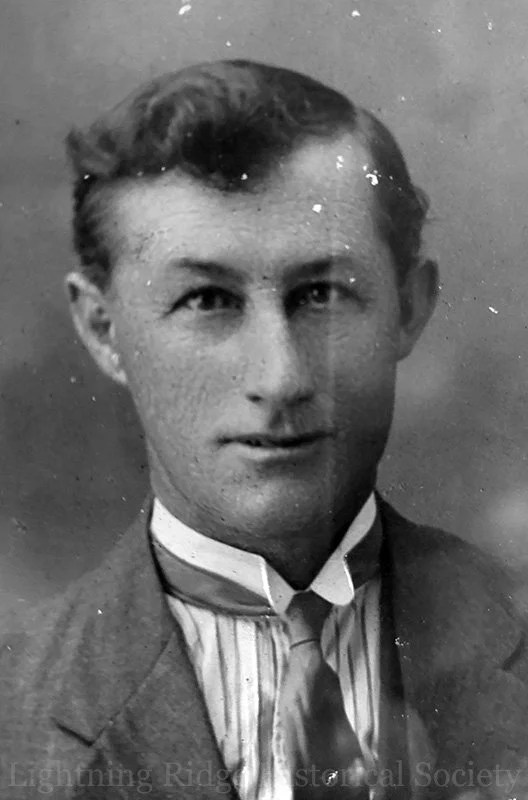“Happy Jack” Burke
“Happy Jack” Burke. Photograph: gillalowe, Ancestry.
John Joseph Bede Ambrose “Happy Jack” Burke (sometimes spelled Bourke) was born on 14 November 1884 at Merriwa, New South Wales, to father Thomas Burke and mother Anne. He married Florence Boules in 1911 at Walgett.
Happy Jack Burke was one of the earliest miners at Lightning Ridge. He signed a petition for postal services at Wallangulla in 1905 and held a Miner’s Right from 1909.
In 1906, Happy Jack and mining partner Charlie Dunstan found one of the largest black opals found by that time, later to be known as Dunstan’s Stone (the stone was named for Dunstan, the claim holder, even though Burke actually found it). The stone was about the size and shape of a pear, mostly green in colour. Dunstan’s Stone, also called The Queen of the Earth and erroneously referred to as The Fire Queen eventually passed through the hands of several early buyers, including Jack Francis and Mr. Bottomley, before leaving the country to eventually end up in the hands of J. D. Rockefeller at a tremendous price markup.
Burke also had a good claim at Thorley’s Six Mile.
In 1908, Jack Burke was mentioned in connection with the Cobar Mary court case at Old Town. Mary was accused of stealing five ten pound notes from a miner named Webb, who had been holding the money for Burke. According to police testimony, Burke and Webb visited her camp after an evening of drinking at the Gooraway Hotel. Both men fell asleep, only to wake up to discover the money missing. Mary was later found at a local store arranging to flee to Collarenebri. She was arrested and charged.
In 1931 he and his brother Paddy found what became known as Paddy Burke’s Field, just south of the modern Lightning Ridge town. The field was lively, but ultimately did not produce a great deal of opal.
Happy Jack Burke passed away on 20 November 1946 at Tamworth, New South Wales at the age of 62. He is buried at Tamworth.
Article: Research by Russell Gawthorpe and Leisa Carney, edited by Russell Gawthorpe. LRHS research compiled by Len Cram and Barbara Moritz. Sources: The Lightning Ridge Book, Stuart Lloyd, 1967, pp. 68, 156, Lightning Ridge - The Home of the Black Opal: Unique to the World, Gan Bruce, 1983, pp. 77, 87, 127; A Journey With Colour: A History of Lightning Ridge Opal 1873-2003, Len Cram, 2003, pp. 46, 68, 113, 156-157, 244, 304, 355-356, 360.

